Crew Dragon Demo-1
Crew Dragon Demo-1 (officially SpaceX Demo-1 or Crew Demo-1) was the first orbital test of the Dragon 2 spacecraft. This first spaceflight was an uncrewed mission that launched on 2 March 2019[6][7] at 07:49:03 UTC or 02:49:03 EST, and arrived at the International Space Station on 3 March 2019, a little over 24 hours after the launch. The mission ended following a successful splashdown on 8 March 2019 at 13:45:08 UTC or 08:45:08 EST.[8][9]
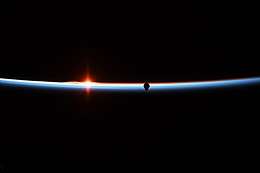 Silhouette of Crew Dragon against the Earth's horizon, as it approaches the International Space Station. | |
| Mission type | ISS technology demonstration |
|---|---|
| Operator | |
| COSPAR ID | 2019-011A |
| SATCAT no. | 44063 |
| Mission duration | 6 days, 5 hours, 56 minutes |
| Orbits completed | 62 |
| Spacecraft properties | |
| Spacecraft | Crew Dragon C201 |
| Manufacturer | SpaceX |
| Launch mass | 12055 kg |
| Dry mass | 6,350 kg (14,000 lb)[1] |
| Start of mission | |
| Launch date | 2 March 2019, 07:49:03 UTC |
| Rocket | Falcon 9 Block 5 (F9-069) B1051.1 |
| Launch site | Kennedy Space Center, LC-39A |
| Contractor | SpaceX |
| End of mission | |
| Recovered by | GO Searcher |
| Landing date | 8 March 2019, 13:45:08 UTC [2] |
| Landing site | Atlantic Ocean [2] |
| Orbital parameters | |
| Reference system | Geocentric orbit |
| Regime | Low Earth orbit |
| Inclination | 51.66° |
| Epoch | 2 March 2020 |
| Docking with ISS | |
| Docking port | Harmony forward[3] |
| Docking date | 3 March 2019, 10:51 UTC[4][2] |
| Undocking date | 8 March 2019, 07:32 UTC[5][2] |
| Time docked | 4 days, 20 hours, 41 minutes[2] |
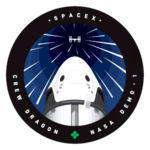 SpaceX insignia for the mission | |
During a separate test, on 20 April 2019, the capsule used on Crew Demo-1 was unexpectedly destroyed when firing the SuperDraco engines at Landing Zone 1.[10]
Mission
The spacecraft tested the approach and automated docking procedures with the International Space Station (ISS), consequent undocking from the ISS, full re-entry, splashdown and recovery steps to provide data requisite to subsequently qualify for flights transporting humans to the ISS. Life support systems were being monitored all throughout the test flight.[11] The same capsule was planned for re-use in an in-flight abort test, but it was destroyed in an accident during a static fire test of its SuperDraco thrusters.[10]
The mission was launched on a SpaceX Falcon 9 Block 5 rocket contracted by NASA's Commercial Crew Program. Initial plans had hoped to see CCDev2 flights as early as 2015.[12] DM-1 was eventually slated for no earlier than December 2016, and then delayed several times throughout 2017.[13][14][15] The first exact date was published by NASA in November 2018 to be 17 January 2019,[16] but this got pushed into February 2019.[17] The static fire took place on 24 January 2019 and the launch date was set to 23 February 2019.[18] By the end of January 2019, the launch was delayed to no earlier than 2 March 2019 according to a FCC filing by SpaceX for Dragon 2 capsule telemetry, tracking, and command.[6]
DM-1 passed its Flight Readiness Review and Launch Readiness Review on 22 February 2019 and 27 February 2019 respectively.[19]
The Falcon 9 with DM-1 rolled out to the LC-39A on 28 February 2019 at around 15:00 UTC and went vertical a few hours later.[20] The spacecraft was launched on 2 March 2019 at 07:49:03 UTC and successfully docked to the ISS on 3 March 2019 at 10:51 UTC.[21][22]
The Dragon 2 capsule successfully undocked from the ISS on 8 March 2019 at 07:32 UTC, performed entry into the Earth's atmosphere and splashed down in the Atlantic Ocean about 200 miles (320 km) off Florida's east coast later that day at 13:45:08 UTC.[9] The capsule was recovered using SpaceX's recovery ship GO Searcher and was returned to the mainland where it was examined and the data collected by the on board sensors was analyzed.[23][24]
Payload
Instead of carrying astronauts to the ISS, this flight had an Anthropomorphic Test Device (ATD) wearing SpaceX's custom flight suit. The ATD is named Ripley, as a homage to Sigourney Weaver's character in the Alien movies franchise. The capsule was weighted similarly to missions with astronauts onboard and carried approximately 400 lb (180 kg) of supplies and equipment including a "super high tech zero-g indicator" (a plush toy).[25][26][27][3] The "zero-g indicator" was left onboard the ISS after undocking, while Ripley returned safely to Earth on 8 March 2019.
Gallery
.jpg) The Dragon 2 capsule at SpaceX's LC-39A Horizontal Integration Facility.
The Dragon 2 capsule at SpaceX's LC-39A Horizontal Integration Facility..jpg) The Dragon 2 capsule mounted aboard the Falcon 9, on the launchpad, with the gangway arm extended from the launch tower to the capsule.
The Dragon 2 capsule mounted aboard the Falcon 9, on the launchpad, with the gangway arm extended from the launch tower to the capsule.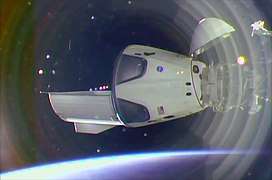 Dragon 2 docked to the International Space Station.
Dragon 2 docked to the International Space Station.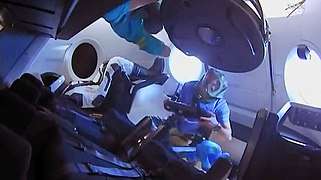 Expedition 58 crew members enter the Dragon 2 for the first time. They are wearing protective gear to avoid breathing particulate matter that may have shaken loose during launch.
Expedition 58 crew members enter the Dragon 2 for the first time. They are wearing protective gear to avoid breathing particulate matter that may have shaken loose during launch.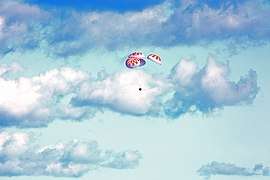 The Dragon 2 capsule landing in the Atlantic Ocean.
The Dragon 2 capsule landing in the Atlantic Ocean.
See also
- Boeing CST-100 Starliner
- Boe-OFT
- Orion
References
- "Environmental assessment of Dragonfly vehicle 2014" (PDF). FAA.

- "Commercial Crew Program American Rockets American Spacecraft American Soil" (PDF). Nasa.gov. NASA. Retrieved 28 February 2019.

- "NASA, SpaceX Launch First Flight Test of Space System Designed for Crew". Nasa.gov. NASA. Retrieved 2 March 2019.

- Harwood, William. "NASA, SpaceX clear Crew Dragon for critical March 2 test flight". CBS News. CBS Interactive Inc. Retrieved 23 February 2019.
- Grush, Loren. "NASA gives SpaceX the okay to launch new passenger spacecraft on uncrewed test flight". The Verge. Vox Media. Retrieved 23 February 2019.
- "Space Exploration Technologies Corp. WF9XGI 0068-EX-ST-2019 FCC Experimental License". fcc.report. Retrieved 5 February 2019.

- "February 6, 2019 – Commercial Crew Program". blogs.nasa.gov. Retrieved 6 February 2019.

- SpaceX #CrewDragon Demonstration Flight Return to Earth. Retrieved 6 May 2020.
- "Crew Dragon's inaugural flight to Station concludes with splashdown – NASASpaceFlight.com". Retrieved 8 March 2019.
- Berger, Eric (22 April 2019). "Here's what we know, and what we don't, about the Crew Dragon accident". Ars Technica. Retrieved 22 April 2019.
- Foust, Jeff (4 February 2016). "SpaceX seeks to accelerate Falcon 9 production and launch rates this year". SpaceNews. Retrieved 21 March 2016.
Shotwell said the company is planning an in-flight abort test of the Crew Dragon spacecraft before the end of this year, where the vehicle uses its thrusters to separate from a Falcon 9 rocket during ascent. That will be followed in 2017 by two demonstration flights to the International Space Station, the first without a crew and the second with astronauts on board, and then the first operational mission.
- Richardson, Derek (5 January 2019). "Falcon 9 with Crew Dragon vertical at Launch Complex 39A". SpaceFlight Insider. Retrieved 3 March 2019.
- "First SpaceX commercial crew test flight could slip to 2019". SpaceNews.com. 3 October 2018. Retrieved 8 December 2018.
- "SpaceX delays commercial crew test flights to latter half of 2018". SpaceNews.com. 11 January 2018. Retrieved 8 December 2018.
- "Report warns of additional commercial crew delays". SpaceNews.com. 6 September 2016. Retrieved 8 December 2018.
- "NASA Invites Media to SpaceX Demo-1 Launch" (Press release). NASA. 21 November 2018. Retrieved 3 March 2019.

- "SpaceX Demo-1 Launch Update". NASA Commercial Crew Program Blog. 10 January 2019. Retrieved 11 January 2019.

- Clark, Stephen. "Falcon 9 rocket fires engines in key test ahead of Crew Dragon demo flight – Spaceflight Now". Retrieved 25 January 2019.
- Ralph, Eric (28 February 2019). "SpaceX's Crew Dragon and Falcon 9 head to Pad 39A for historic launch debut". TESLARATI.com. Retrieved 28 February 2019.
- Clark, Stephen. "SpaceX's Crew Dragon rolls out for test flight – Spaceflight Now". Retrieved 28 February 2019.
- "Crew Dragon successfully conducts debut docking with the ISS – NASASpaceFlight.com". Retrieved 3 March 2019.
- "Demo-1 Underway: Crew Dragon Launches on Debut Flight – Commercial Crew Program". blogs.nasa.gov. Retrieved 2 March 2019.

- Mission SpX-DM1 accomplished: the SpaceX Crew Dragon spacecraft has come back to Earth. Massimo Luciani, Tachyon Beam. March 8, 2019.
- "Crew Dragon Lifted Onto Recovery Ship – Commercial Crew Program". blogs.nasa.gov. Retrieved 12 April 2019.

- Grush, Loren (22 February 2019). "NASA gives SpaceX the okay to launch new passenger spacecraft on uncrewed test flight". The Verge. Retrieved 23 February 2019.
- Boyle, Alan. "NASA, SpaceX and a test dummy are ready for Dragon 2's first trip to space station". GeekWire. GeekWire, LLC. Retrieved 28 February 2019.
- Bartels, Meghan. "Meet Ripley, SpaceX's Dummy Astronaut Riding on Crew Dragon Test Flight". Space.com. Retrieved 1 March 2019.
External links
| Wikimedia Commons has media related to SpaceX Demo-1. |
- Crew Demo-1 Mission press kit (Archived 2 March 2019)
- Dragon at SpaceX (Archived 2 March 2019)
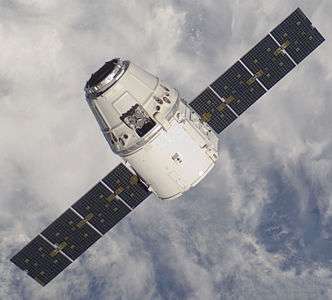
.jpg)

